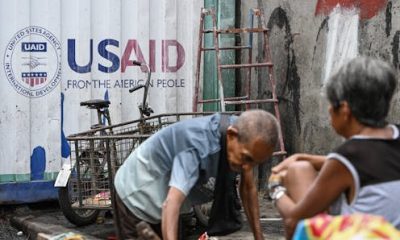
The police have regularly been called in to squelch student protests over the past century. Michael M. Santiago / Getty Images
Columbia University has become the epicenter of student protests over the war in Gaza. In the following Q&A, Stefan Bradley, a history professor at Amherst College and author of the 2009 book “Harlem vs. Columbia University: Black Student Power in the Late 1960s,” touches on the similarities and differences between the protests of the 1960s and now.
How do protests now differ from those of 1968?
Similarities lie in students’ opposition to war, racism and prejudice.
A key difference is social media, which has contributed greatly to the ability of students to mobilize. News of various actions and protests spreads quickly.
Violence or the threat thereof is another difference. Initial demonstrations at Columbia University in April 1968 started with the threat of violence between radical students who wanted to end the university’s ties to war research during the Vietnam War and terminate a university gymnasium construction project and mostly white athletes who wanted to push forward with it. The gym had been designed for mostly Black and brown Harlem residents to enter one door and Columbia affiliates in another. Columbia affiliates also had greater access to various parts of the gym, leading residents to refer to the situation as “Gym Crow.”
Considering the institution’s history of expansion and the uprisings surrounding the assassinations of the Rev. Martin Luther King Jr. that took place just weeks earlier, tension was in the air. Taking the demonstration to the gym site, student activists then clashed with police in the park before returning to campus to take over Hamilton Hall, the same building where dozens of Columbia student activists in this year’s protests over Gaza were arrested on the night of April 30, 2024.
Until April 30, students were less disruptive than they’d been in the past. The encampments on the South Lawn did not prevent major functions of the university.
But after students took over Hamilton Hall, the calculus has changed. By breaking into the building and barricading themselves in, the campus activists provided administrators with even more justification to call on the police to remove them.
How so?
Officials in 1968 called city police to forcibly remove students, who had subsequently taken over four more buildings, and to make arrests. It quickly turned violent. Police charged into buildings and around campus to make arrests. In a building called Math Hall, activists, including Tom Hayden – author of the Port Huron Statement, a leftist manifesto that called on students to work against racism, imperialism and poverty – fought back. Police struck observers and activists alike with batons.
With long-standing critiques of the university in their minds, and the death of King in their hearts, Harlem residents were ready to support protesting students.
NYPD officers run to head off striking students during the series of protests on the campus of Columbia University in New York City in 1968.
Authenticated News via Getty Images
Black Power leaders such as Stokely Carmichael and H. Rap Brown explained to the press that if Columbia did not negotiate with the Black students in Hamilton, then the university would have to deal with the “brothers out on the streets” of Harlem. The threat of a coalition with Harlem neighbors aided in the success of the activists in ending the university’s construction of a private gymnasium in nearby Morningside Park and the cessation of the school’s ties to the Institute for Defense Analyses, a consortium of flagship and elite higher education institutions conducting government-funded defense research during the Cold War.
The threat of violence loomed with the recent building capture and arrests at Hamilton. The 2024 protest is starting to resemble the 1968 protest in terms of students feeling uncomfortable with their university’s decision-making and administrators feeling compelled to regain control of campus. The differences are becoming slimmer and the similarities thicker.
What about the use of symbolism?
In 1968 and today, students used symbolism to send a message.
Fifty-six years ago, demonstrators also took over Hamilton Hall – named after Alexander Hamilton – renaming it Malcolm X University and hanging images of Stokely Carmichael.
Today, protesters renamed it Hind’s Hall – in honor of a 6-year-old Palestinian child killed by Israeli tank fire in Gaza – and flew a Palestinian flag from a Hamilton window.
What is the legacy of the 1968 protest?
The major legacy is that students are the moral compass of these well-endowed, elite institutions – even if they engage in disruptive behavior. They are willing to act on campus when no one else will. If left to the trustees, administrators, faculty and staff, the university would likely be quiet and civil while waiting for the marketplace of ideas and countless committees to suss out what to do about real-time humanitarian crises.
Young people have always been impatient in their calls for justice. In 1968, the issues were Columbia’s construction of a gymnasium in West Harlem and the university’s relationship with the IDA; in the 1980s, it was the university’s financial interests in apartheid South Africa; and in the 2010s, the school’s investments in private prison corporations. The 1968 rebellion taught later generations not to accept indiscriminate killing and injustice.
Another legacy is that the deployment of police to break up demonstrations may end disruptions in the short term, but it may also end up radicalizing moderate students who see their friends get arrested or injured.
What makes a protest successful?
Of course, students want every demand met, but that is often unlikely to happen. A better mark of success is the disruption of the status quo and the amount of attention they bring to issues. In that regard, the protests have been a success.
Conflict at a place like Columbia garners attention because of its location in the media capital of the world. When administrators respond to issues students raise by focusing on policies and procedures, it can give the impression that the issues are not important.
Fifty-six years ago, campus activists inspired students abroad to chant “Two, Three, Many Columbias!” Administrators may want to remain apolitical, but campus demonstrators want to know where their tuition goes and have a say in how it is spent. Highlighting the conflict between key sources of funding – the students paying tuition and the school’s major donors – is a notable victory.
How unprecedented are the student arrests?
There is precedence for student arrests on and off campus. The NYPD violently arrested more than 700 students in April 1968 and dozens more in May.
When students in the 20th century rebelled against the idea that the university was supposed to act in the place of their parents, higher education officials turned to law enforcement in the hope that students would comply.
There were arrests at the Fisk Institute in 1925 for protests over strict student rules, including those that limited participation in civil rights movements; there was the Berkeley Free Speech Movement, when students demanded the right to pass out civil rights literature on campus.
In 1970, there were also police or National Guard-involved shootings of students at Jackson State and Kent State, a predominantly white university.
In 2016, police battled students protesting tuition hikes in California. There were no fatal shootings, but nonlethal weapons like pepper spray were deployed. Inviting police onto campus introduces an element that concedes power to those not interested in the educational well-being of students.
Stefan M. Bradley does not work for, consult, own shares in or receive funding from any company or organization that would benefit from this article, and has disclosed no relevant affiliations beyond their academic appointment.
Advertisement

Advertisement
Contact Us
If you would like to place dofollow backlinks in our website or paid content reach out to info@qhubonews.com











